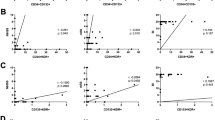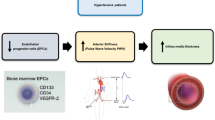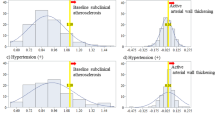Abstract
Recent studies suggest that reductions in circulating endothelial progenitor cells (EPCs) may contribute to the development of atherosclerosis. However, whether reduced circulating EPCs contribute to cerebrovascular disease remains undefined. We tested the hypothesis that reduced circulating EPCs was associated with an increased burden of carotid atherosclerosis. The level of circulating CD34+/KDR+ EPCs and the extent of carotid atherosclerosis were determined in 30 patients with a history of atherothrombotic ischaemic stroke and 30 age- and sex-matched controls (mean age: 63±2 years; 63% men). Stroke patients, compared with controls, had significantly higher carotid mean maximum intima-media thickness (mmIMT) (1.08±0.05 versus 0.90±0.02 mm, P=0.002), prevalence of carotid plaque (60.0 versus 23.3%, P=0.004) and a lower number of circulating CD34+/KDR+ EPCs (235.7±45.5 versus 400.4±56.8 cells/μl, P=0.027). The circulating CD34+/KDR+ EPC count correlated negatively with carotid mmIMT (r=−0.50, P<0.001), and was an independent risk factor for increased carotid mmIMT>1 mm (odds ratio (OR): 7.71; 95% confidence interval (CI): 1.62–36.74, P=0.010) and the presence of carotid plaque (OR: 7.04; 95% CI: 1.95–25.43, P=0.003). Furthermore, stroke patients with low (<25th percentile of controls) as compared to those with normal CD34+/KDR+ EPC count had a significantly greater carotid mmIMT (1.21±0.07 versus 0.93±0.05 mm, P=0.005) and a significantly higher prevalence of carotid plaque (87.5% versus 28.6%; P=0.001). Our observations suggested that reduced circulating EPC may contribute to the progression of carotid atherosclerosis. Circulating EPC count may provide a novel marker for the burden of carotid atherosclerosis.
This is a preview of subscription content, access via your institution
Access options
Subscribe to this journal
Receive 12 digital issues and online access to articles
$119.00 per year
only $9.92 per issue
Buy this article
- Purchase on Springer Link
- Instant access to full article PDF
Prices may be subject to local taxes which are calculated during checkout




Similar content being viewed by others
References
Asahara T, Murohara T, Sullivan A, Silver M, van der Zee R, Li T et al. Isolation of putative progenitor endothelial cells for angiogenesis. Science 1997; 275: 964–967.
Rafii S, Lyden D . Therapeutic stem and progenitor cell transplantation for organ vascularisation and regeneration. Nat Med 2003; 9: 702–712.
Hill J, Zalos G, Halcox J, Schenke W, Waclawiw M, Quyyumi A et al. Circulating endothelial progenitor cells, vascular function, and cardiovascular risk. New Eng J Med 2003; 348: 593–600.
Schmidt-Lucke C, Rossig L, Fichtlscherer S, Vasa M, Britten M, Kamper U et al. Reduced number of circulating endothelial progenitor cells predicts future cardiovascular events: proof of concept for the clinical importance of endogenous vascular repair. Circulation 2005; 111: 2981–2987.
Werner N, Kosiol S, Schiegl T, Ahlers P, Walenta K, Link A et al. Circulating endothelial progenitor cells and cardiovascular outcomes. New Eng J Med 2005; 353: 999–1007.
Ghani U, Shuaib A, Salam A, Nasir A, Shuaib U, Jeerakathil T et al. Endothelial progenitor cells during cerebrovascular disease. Stroke 2005; 36: 151–153.
Pignoli P, Tremoli E, Poli A, Oreste P, Paoletti R . Initmal plus medial thickness of the arterial wall: a direct measurement with ultrasound imaging. Circulation 1986; 74: 1399–1406.
Baldassarre D, Amato M, Bondioli A, Sirtori C, Tremoli E . Carotid artery intima-media thickness measured by ultrasonography in normal clinical practice correlates well with atherosclerosis risk factors. Stroke 2000; 31: 2426–2430.
Makita S, Nakamura M, Hiramori K . The association of C-reactive protein levels with carotid intima-media complex thickness and plaque formation in the general population. Stroke 2005; 36: 2138–2142.
Ebrahim S, Papacosta O, Whincup P, Wannamethee G, Walker M, Nicolaides A et al. Carotid plaque, intima media thickness, cardiovascular risk factors, and prevalent cardiovascular disease in men and women: the British Regional Heart Study. Stroke 1999; 30: 841–850.
Bots M, Hoes A, Koudstaal P, Hofman A, Grobbee D . Common carotid intima-media thickness and risk of stroke and myocardial infarction: the Rotterdam Study. Circulation 1997; 96: 1432–1437.
O’Leary D, Polak J, Kronmal R, Manolio T, Burke G, Wolfson S . Carotid-artery intima and media thickness as a risk factor for myocardial infarction and stroke in older adults. Cardiovascular Health Study Collaborative Research Group. New Engl J Med 1999; 340: 14–22.
Acknowledgements
This study was supported by the CRCG Small Project Funding of University of Hong Kong (Project no. 200507176137).
Author information
Authors and Affiliations
Corresponding author
Rights and permissions
About this article
Cite this article
Lau, KK., Chan, YH., Yiu, KH. et al. Burden of carotid atherosclerosis in patients with stroke: relationships with circulating endothelial progenitor cells and hypertension. J Hum Hypertens 21, 445–451 (2007). https://doi.org/10.1038/sj.jhh.1002178
Received:
Revised:
Accepted:
Published:
Issue Date:
DOI: https://doi.org/10.1038/sj.jhh.1002178
Keywords
This article is cited by
-
Endothelial progenitor cells and plaque burden in stented coronary artery segments: an optical coherence tomography study six months after elective PCI
BMC Cardiovascular Disorders (2017)
-
Endothelial progenitor cells in ischemic stroke: an exploration from hypothesis to therapy
Journal of Hematology & Oncology (2015)
-
Global trends, potential mechanisms and early detection of organ damage in SLE
Nature Reviews Rheumatology (2013)
-
Myocardial dysfunction in patients with type 2 diabetes mellitus: role of endothelial progenitor cells and oxidative stress
Cardiovascular Diabetology (2012)
-
Circulating endothelial progenitor cells are reduced in SLE in the absence of coronary artery calcification
Rheumatology International (2012)



